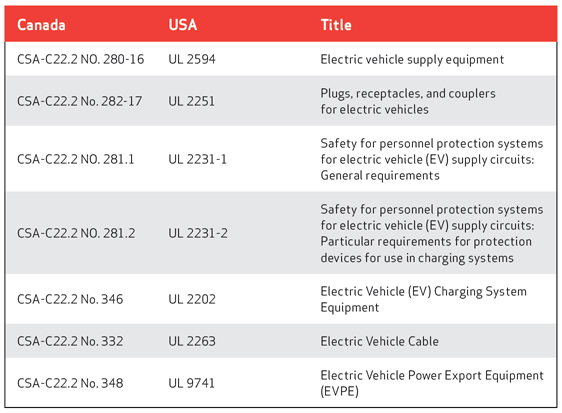A significant portion of global greenhouse gas (GHG) emissions is attributed to the transportation sector. As the impact of climate change becomes apparent, governments are racing to reduce their carbon footprint by enacting policies and regulations to decarbonize the transportation sector through electrification. The proliferation of battery electric vehicles (BEVs) will require the convergence and collaboration of the transportation sector with electrical utilities and manufacturers, creating both challenges and opportunities. Electrical utilities will be required to maintain a resilient grid with increased demand from BEVs and integration of renewables. Manufacturers of charging equipment will be required to comply with the safety rules and regulations in different jurisdictions to sell their products and help ensure safe installation and reliable operations. There must be sufficient charging infrastructure available to increase consumer confidence and overcome the barriers to mass-market adoption.
The challenges faced by the transportation sector, electrical utilities and manufacturers can be partly addressed through codes and standards, which can help ensure quality and safety of services, products or systems for consumers. Codes and standards can help facilitate the safe and sustainable deployment of infrastructure that is
required to electrify and consequently decarbonize the transportation sector. Moreover, standards encourage compatibility and interoperability, promote environmental protection and enhance trade. When harmonized at the regional or international level codes and standards can help reduce the regulatory burden by aligning common requirements and ultimately reducing time-to-market and costs for manufacturers. Binational standards are applicable for Canada and the United States, and trinational standards include Mexico.
CSA Group is accredited by the Standards Council of Canada (SCC) and the American National Standards Institute (ANSI) to develop standards in both Canada and the United States. The mission of CSA Group is to enhance the lives of Canadians through the advancement of standards in the public and private sectors and the organization is a leader in standards development, research, education, and advocacy. Standards development promotes safety, environmental stewardship and economic efficiency in an open, transparent and consensus-based development process with technical rigor from volunteer members organized in committees with balanced representation. The deliverables of standards development can include fully accredited solutions, guidance documents or workshop agreements — all designed to meet the changing needs of the market. Other CSA Group activities include research that aims to explore standards gaps in existing and emerging technologies or provide evidence-based content to inform requirements in standard; promotion of stakeholder education and usability of standards; and advocacy and public awareness for standards across various sectors. Codes and standards can help facilitate the safe and sustainable deployment of infrastructure that is required to electrify and consequently decarbonize the transportation sector.
Since 2010, CSA Group has laid the foundation for future standards development activities with electrical product safety certification and installation standards for charging technologies that are aligned across North America. Safety standards for the installation and maintenance of electrical equipment, including BEV charging infrastructure, are covered in the Canadian Electrical Code (CE Code). Sections 8 and 86 of the CE Code apply to BEV charging infrastructure and provide requirements for equipment installation to prevent fire and shock hazards. In addition to the installation requirements, the CE Code indicates the use of approved equipment that must comply with specific product safety certification standards. Product safety certification standards, used for conformity assessment, have been developed or are under development for infrastructure such as Electric Vehicle Supply Equipment (EVSE), Direct Current Fast Chargers (DCFC), wireless chargers, plugs, receptacles and couplers. As discussed below, CSA Group has leveraged the CE Code and discrete product standards to advance a systems approach to seamlessly integrate BEVs to the electrical grid with techniques such as energy management, bidirectional power transfer and energy storage. These techniques will help overcome the challenges of increased energy demand and ultimately support the widescale proliferation of BEVs and a net reduction in GHG emissions.
Canadian electrical code
Playing a key role in helping to specify the safe installation of BEV charging infrastructure, the Canadian Electrical Code (CE Code) outlines the installation and maintenance of electrical equipment and can be adopted into legislation with or without modifications. Electrical installation requirements related to BEVs are specified in Sections 8 and 86 of the CE Code, Part I. The installed equipment must be certified by a certification organization, accredited by the SCC, to the relevant certification standard listed in Appendix A (Part II) of the CEC or other applicable standards. This is referred to as approved equipment. Part II of the CEC has individual standards that provide definitions and specify construction, marking and test requirements for a single class or closely allied group of electrical equipment.
Section 8 of the CE Code defines an Electric Vehicle Energy Management System (EVEMS) as a means to control EVSE loads through a variety of techniques from disconnecting the load to using communications-based control. Section 8 permits disregarding the EVSE loads, particularly when these loads are added to the load of an existing building if an EVEMS monitors the service and feeder. An EVEMS limits the electrical service and feeder sizes, therefore, eliminating any costly infrastructure upgrades and becoming a more affordable option for deploying EVSE in new and existing multi-unit residential buildings (MURBs). Section 86 of the CE Code covers the installation of EVSE and DCFCs by specifying the ampacity, protection, and signage requirements as well as specifying appropriate indoor and outdoor installation locations.
Electric vehicle supply equipment
Level I (1.1 kW) and Level II (3.3 kW to 19.2 kW) EVSE are affordable options for applications facilitating longer charging durations. The product safety certification standard for an EVSE providing AC power to an onboard charger of a BEV is CSA-C22.2 NO. 280-16 (trinational). EVSE is used with plugs, receptacles, vehicle inlets and connectors for which the product safety certification standard is CSA-C22.2 No. 282-17 (trinational). EVSE installations have accessible parts that can pose shock hazards. CSA-C22.2 NO. 281.1 (trinational) specifies general requirements in a product safety certification standard to reduce the risk of electrical shock from the accessible parts of an EVSE. CSA-C22.2 NO. 281.2 (trinational) states the particular requirements for electrical protection devices in a product safety certification standard.
Direct current fast chargers
For public locations such as highway corridors requiring shorter charging times, high-powered DCFCs are the best option. CSA-C22.2 No. 346 (binational) is a product safety certification standard currently under development for DCFCs.
Wireless power transfer
BEVs can also be charged wirelessly without the need for a physical connection. CSA Group has adopted the first part of the IEC Wireless Power Transfer (WPT) standard, CSA C22.2 No. 61980-1, with the appropriate Canadian deviations to maintain consistency with the requirements specified in the CE Code. This IEC standard, the first of four parts, contains the general requirements for WPT with background and definitions for efficiency electrical safety, electromagnetic compatibility, and electromagnetic fields.
BEV cables
Complex high-powered charging technologies will require complex cable design. CSA-C22.2 No. 332 (trinational) is a product safety certification standard to address the design, construction, and performance requirements for power, signal and control cables used between an EVSE or DCFC and BEV.
Electric vehicle energy management systems
To seamlessly integrate BEVs into the electrical grid, a systems approach is used to take the discrete product safety certification standards and develop demand management strategies using energy management systems, bidirectional power transfer, and energy storage. As discussed earlier, the definition and installation requirements of the EVEMS are specified in Section 8 of the CE Code. EVEMS can monitor the service or feeder loads and control the EVSE loads accordingly, thus reducing costs associated with expensive capacity upgrades. CSA Group first published a research report on this topic in 2019, leading to the publication of a guidance document, SPE-343, applicable in both Canada and the United States. The product safety certification standard for an EVEMS, C22.2 No. 343, is currently under development and will address requirements for the controller, software, sensor and communications that are necessary to prevent overloading of the circuit.
Vehicle-to-grid
The second approach is to seamlessly integrate BEVs to the grid with bidirectional power transfer, or vehicle-to-grid (V2G). BEVs can be used as distributed energy resources, supplying or extracting power from the grid in a flexible manner to maximize efficiency and increase renewable integration. CSA-C22.2 No. 348 (binational), currently in development, is a product safety certification standard that will address the safety requirements for equipment that will facilitate the bi-direction power transfer from the BEV.
Battery management systems
Another approach for efficient grid integration of BEVs is the use of lithium-ion batteries (LIBs) for energy storage. The generation of electricity from various sources, including renewables, and demand from unpredictable events, such as high-power charging with DCFCs, can be managed with LIBs. LIBs operating in unsafe conditions present a high risk of fire and explosion hazards. A Battery Management System (BMS) can maintain the battery in a functional state and respond accordingly upon detection of unsafe operating conditions. To address the requirements for the design, performance and safety of the BMS, CSA Group has initiated the development of a binational product safety certification standard, C22.2 No. 340. This standard will be applicable to batteries in stationary and mobile applications in residential, commercial and industrial settings.
To play a role in advancing the systems approach to BEV standards development, CSA Group invites experts to consider participating in technical committees or provide comments during the public review period. As technologies advance to facilitate the proliferation of BEVs, input from experts will be required for the development of robust and harmonized codes and standards. To learn more about CSA Group’s standards works related to BEVs, visit https://community.csagroup.org/community/electrical/electric-vehicles.

Table 1: Equivalent standards in Canada and the United States.
Umer Khan is a project manager at CSA Group and is responsible for facilitating the development of standards related to electric vehicle (EV) infrastructure. Khan also collaborates with stakeholders in the EV ecosystem to identify standardization gaps and priorities for new and emerging technologies.
Brent Hartman is the director of Fuels & Transportation Standards for CSA Group. Hartman leads the development and implementation of the standards strategy for the fuels and transportation sectors in the United States and Canada. Technology areas in the sector include hydrogen, fuel cells, electric vehicles, connected and automated vehicles, biogas and gas-fired appliances and equipment.






